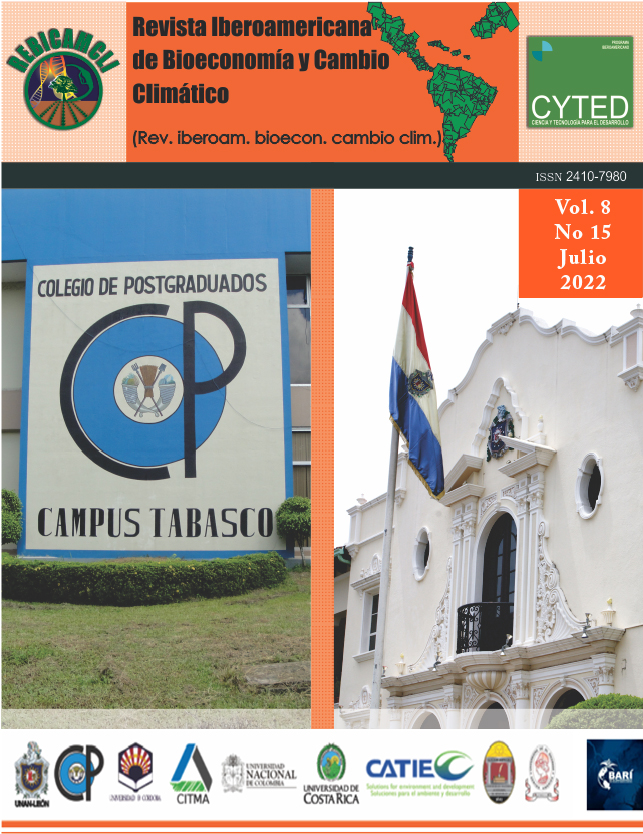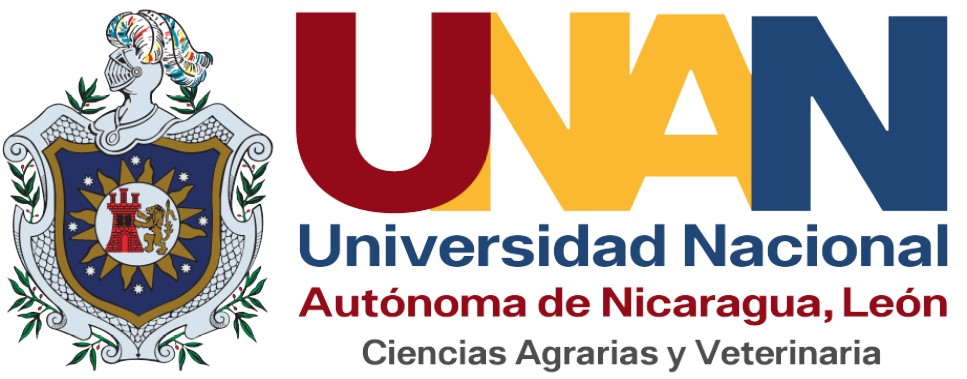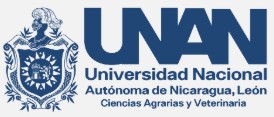Yield of Maize Alley Cropped with Inga Trees and Several Levels of Natural Fertilizers
DOI:
https://doi.org/10.5377/ribcc.v8i15.14383Keywords:
Zea mays, Inga spp, guama, rock phosphate, potassium and magnesium sulfateAbstract
In the experimental station of the Regional University Center of the Atlantic Center (CURLA, UNAH), La Ceiba, Atlántida, Honduras. The yield of maize (Zea mays L.) alley cropped with existing guama trees (Inga spp.) to the application of potassium sulfate and magnesium (K2SO4 + Mg) fertilizer at 0, 20, 40 kg. ha-1 with six replicates, and phosphoric rock (RF) at 0, 20, 40, and 80 kg·ha-1 with four replicates, was evaluated. Prior to sowing the crop, dolomitic lime (Ca3(PO4)2CaF2) was applied at a rate of 2 ton·ha-1. Nitrogen was provided by the guama trees. In year 2014, the highest average yield of maize was 1558 kg·ha-1 and it was statistically significant. The treatments that performed better were those of K2SO4 + Mg, and RF, at 20, 40, and 80 kg·ha-1. The high average yield of maize during the first year, its stabilization during the next two years, and the no application of nitrogen fertilizers, has pointed out to the availability of nitrogen for the crop under an alley cropping system with guama trees (Inga. spp.).
Downloads
Metrics
References
Akonde T. P.; Kuhne N. R. F.; Steinmuller y Leihner D. E. (1997). Alley cropping in an Ultisol in sub-humid Benin. Part 3: Nutrient budget of maize, cassava and trees. Agroforestry Systems 27: 213-226.
Altieri M. A. y Nicholls C. I. (2005). Agroecology and the Search for a Truly Sustainable Agriculture. 1st edition. UNEP. Berkeley. ISBN 968-7913-35-5 https://agroeco.org/doc/agroecology-engl-PNUMA.pdf)
Buresh R. J. y Tian. G. (1998). Soil improvement by trees in sub-Saharan Africa. Agroforestry Systems 38: 51-76. https://doi.org/10.1023/A:1005948326499
Capetillo-Burela, A., López-Collado, C. J., Zetina-Lezama, R., Reynolds-Chávez, M. A., Matilde-Hernández, C., Cadena-Zapata, M., & López-López, J. A. (2021). Modelo conceptual de fertilización nitrogenada para maiz (Zea mays L.) en Veracruz, México. Rev. Iberoam. Bioecon. Cambio Clim., 7(14), 1617–1631. https://doi.org/10.5377/ribcc.v7i14.12606
Campodónico, F. (2012). Evaluación de rendimientos de maíz en función de distintas densidades de siembra, en el partido de Lima, provincia de Buenos Aires [en línea]. Trabajo final de ingeniería en producción agropecuaria. Facultad de Ciencias Agrarias. Universidad Católica Argentina. Disponible en: http://bibliotecadigital.uca.edu.ar/repositorio/tesis/evaluacion-rendimientos-maiz-funcion-densidades.pdf [Fecha de consulta]
Carreón-Santos; R. J. y Valdez-Hernández, J. I. (2014). Estructura y diversidad de vegetación secundaria derivada de una selva mediana subperennifolia en Quintana Roo. Revista Chapingo Serie Ciencias Forestales y del Ambiente, 20(1), 119-130. doi: 10.5154/r. rchscfa.2013.06.023
Cox, W. J. and Cherney, D. J. R. (2001). Row spacing, plant density, and nitrogen effects on corn silage. Agronomy Journal. 93, pp. 597–602.
Cao, Y. P.; Lin, C. L. y Wang, X. R.. (1995). Phenotipic difference in Phosphorus utilization by two maize genotypes. Acta - Agriculturae - Universitatis - Pekinensis. 21, pp. 111-116.
Colon-García, A.; Catari-Yujra, G., y Alvarado, E. (2021). Los senderos productivos de la bioeconomía: El caso Honduras. Rev. Iberoam. Bioecon. Cambio Clim., 7(14), 1713-1726.
Dechen, A. y Nachtigall, G. (2007). Fertilidade do Solo. Elementos requeridos a nutrição de plantas. 1ª Ed. SBCS Vicosa-Mina Gerais. BR.1017 p.
Derlagen, C.; De Salvo, C. P.; Egas Y. J. J. y Pierre, G. (2019). Análisis de políticas agropecuarias en Honduras. BID-MG-787. 82 p.
DICTA. (2012). Informe técnico, Previo requisito para la liberación de las variedades: "esperanza", (S07TLW-AB) y "DICTA-MAYA" (S03TLW-3B), a estrés limitado. Tegucigalpa. Honduras. 14 p.
Estrada, H. I. R.; Hidalgo, M. C.; Guzmán, P. R.; Almaraz, S. J. J.; Navarro, G. H.; y Etchevers, B. J. D. (2017). Indicadores de calidad de suelo para evaluar su fertilidad. Agrociencia, 51(8), pp. 813-831. Recuperado en 12 de junio de 2022, de http://www.scielo.org.mx/scielo.php?script=sci_arttext&pid=S1405-31952017000800813&lng=es&tlng=es
Ernani, P; Almeida, J; Dos Santos, F. (2007). Fertilidade do Solo. Potássio. 1ª Ed. SBCS. Viçosa - Mina Gerais, BR.1017 p.
Granada, J. A. (2010). Calibración de fertilización fosfatada de trigo, soja y maíz cultivados en siembra directa en dos suelos del Departamento de Caaguazú. Tesis Ing. Agr. San Lorenzo, Departamento de Suelos y Ordenamiento Territorial, CIA, FCA, UNA. 57 p.
García M. L. E.; Valdez H. J. I.; Luna. C. M. y López. M. R. (2015). Structure and diversity of arboreal vegetation in coffee agroforestry systems in Sierra de Atoyac, Veracruz. Madera y Bosques 21(3): 69-82. http:// www.redalyc.org/articulo.oa?id=61743002005
Garbanzo, L. G.; Alvarado, H. A.; Vargas-Rojas, J. C.; Cabalceta, A. G. y Vega, V. E. V. (2021). Fertilización con nitrógeno y potasio en maíz en un Alfisol de Guanacaste, Costa Rica. Agronomía Mesoamericana, 32 (1), pp. 137-148. https://doi.org/10.15517/am.v32i1.39822
Havlin, J. L.; Beaton, J. D.; Tisdale, S. L. y Nelson. W. L. (2005). Soil fertility and fertilizers. 7th ed. Pearson Prentice Hall, Upper Saddle River, NJ.
Hands, M. (2021). The search for a sustainable alternative to slash-and-burn agriculture in the World's rain forests: the Guama Model and its implementation. R. Soc. Open Sci. 8:201204. https://doi.org/10.1098/rsos.201204
Jaimes S. Y. Y.; Agudelo C. G. A.; Báez D. E. Y.; Rengifo E. G. A. y Rojas M. J. (2021). Modelo productivo para el cultivo de cacao (Theobroma cacao L.) en el departamento de Santander. Corporación Colombiana de Investigación Agropecuaria - AGROSAVIA. https://doi.org/10.21930/agrosavia.model.7404647
Jaramillo Albuja, J. G., Peña Olvera, B. V., Hernández Salgado, J. H., Díaz Ruiz, R., y Espinosa Calderón, A. (2018). Caracterización de productores de maíz de temporal en Tierra Blanca, Veracruz. Revista mexicana de ciencias agrícolas, 9(5), 911-923. https://doi.org/10.29312/remexca.v9i5.1501
Karlen, D. L. and Camp, C. R. (1985). Row spacing, plant population, and water management effects on corn in the Atlantic Coastal Plaint Agronomy Journal. 77, pp. 393–398.
Lal, R. (1988). Soil erosion research on steep lands. In: pp. 45-53. W.C. Moldenhauer and N. W. Hudson (Eds.). Conservation Farming on Steep Lands. SWCS, Ankeny, IA. https://www.redalyc.org/articulo.oa?id=34120113
Leblanc H. A.; McGraw R. L. y Nygren P. (2007). Dinitrogen-fixation by three neotropical agroforestry tree species under semi-controlled field conditions. Plant and Soil 291(1-2):199-209 DOI: 10.1007/s11104-006-9186-0 https://doi.org/10.1007/s11104-006-9186-0
López-González, Á.; Zúniga-González, C.; López, M.; Quirós-Madrigal, O.; Colón-García, A.; Navas-Calderón, J.; Martínez-Andrades, E., y Rangel-Cura, R. (2016). Estado del arte de la medición de la productividad y la eficiencia técnica en América Latina: Caso Nicaragua. Rev. Iberoam. Bioecon. Cambio Clim., 1(2), 76-100. https://doi.org/10.5377/ribcc.v1i2.2478
Lardizabal, R. (2012). Producción de maíz bajo el manejo integrado de cultivo. USAID y la Fundación Hondureña de Investigación Agrícola. 80 p. https://dicta.gob.hn/files/2012,-Manual-de-produccion-de-maiz,-G.pdf
Macías-Coutiño, P.; Guevara-Hernández, F.; Ruiz-Valdiviezo, V.; Reyes-Sosa, M.; La O Arias, M., y Pinto-Ruiz, R. (2021). Efecto de tres consorcios microbianos en maíz (Zea mays L.) en Villaflores, Chiapas. Rev. Iberoam. Bioecon. Cambio Clim., 7(13), 1576-1586. https://doi.org/10.5377/ribcc.v7i13.11424
Manson, R. H.; Contreras, H. A. y López-Barrera, F. (2008). Estudios de la biodiversidad en cafetales. En R. H. Hanson, V. Hernández-Ortíz, S. Gallina, & K. Mehltreter (Eds.), Agrosistemas cafetaleros de Veracruz: biodiversidad, manejo y conservación (pp. 1-14). México: Instituto de Ecología A. C. (INECOL) e Instituto Nacional de Ecología (INE-SEMARNAT). Retrieved from http:// www3.inecol.edu.mx/biocafe/?option=com_content&view=article&id=26:acv&catid=13:libros&Itemid=22
MARENA (2008), Estrategia Nacional de Medio Ambiente y Cambio Climático. Ministerio del Ambiente y los Recursos Naturales. Nicaragua. http://www.marena.gob.ni/
Marques A., E.; Prat, J.; Vargas-Moreno, J. C. y Acevedo, M. C. (2019). Honduras: Un enfoque territorial para el desarrollo. Inter-American Development Bank. https://doi.org/10.18235/0001679
Medina M. J.; Alejo S. G.; Soto R. J. M. y Hernández P. M. (2018). Rendimiento de maíz grano con y sin fertilización en el estado de Campeche. Revista mexicana de ciencias agrícolas, 9(spe21), 4306-4316. https://doi.org/10.29312/ remexca.v0i21.1532Reyes C., P. 1990a. Diseño de experimentos aplicados. Editorial Trillas. México. 334 p. https://doi.org/10.29312/remexca.v0i21.1532
Moore, A.; Hines, S., Brown, B.; Falen, C., Haro, M. M.; Chahine, M.; Norell, R.; Ippolito, J.; Parkinson, S. y Satterwhite, M. (2014). Soil–Plant Nutrient Interactions on Manure-Enriched Calcareous Soils. Revista Agronom 106(1), pp. 73-80. https://doi.org/10.2134/agronj2013.0345
Medina, L. (2018). Estrategia nacional de uso y manejo de fuego 2018-2028 y su plan de acción. Tegucigalpa: CLIFOR.
Mendez V. E.; Gliessman S. R. y Gilbert G. S. (2007). Tree biodiversity in farmer cooperatives of a shade coffee landscape western El Salvador. Agriculture Ecosystems Environment 119(1):145-159. doi:10.1016/j.agee.2006.07.004 https://doi.org/10.1016/j.agee.2006.07.004
Milán P., J., & Zúniga-Gonzalez, C. (2021). Necesidades de investigación y transferencia de tecnologías sobre cambio climático en Nicaragua: Una oportunidad en la Bioeconomía. Rev. Iberoam. Bioecon. Cambio Clim., 7(13), 1518-1543. https://doi.org/10.5377/ribcc.v7i13.11270
Nygren P., Fernández M., Harmand J. M. y Leblanc H. (2012). Symbiotic dinitrogen fixation by trees: an underestimated resource in agroforestry systems? Nutrient Cycling in Agroecosystems 94:(2-3):123- 160. DOI: 10.1007/s10705-012-9542-9 https://doi.org/10.1007/s10705-012-9542-9
OMM (2020). World Meteorological Organization at a glance [Página principal en Internet], World Meteorological Organization; 2020[actualizada en febrero 2020; acceso 14 febrero 2020]. [aprox. 2 pantallas]. Disponible en: https://public.wmo.int/en/resources/united_in_science
Palm C. A. y Sánchez P. A. (1990). Decomposition and nutrient release patterns of the leaves of three tropical legumes. Biotropica 22:330-338. https://doi.org/10.2307/2388550
Pennington, T.D. (1997). The Genus Inga Botany. Richomnd, London: Royal Botanic Gardens Kew. Surrey, Reino Unido. 844 p. ISBN: 1-900347-12-1.
Reta, S. D. G.; Cueto, W. J. A.; Gaytán, M. A. y Santamaría, C., J. (2007). Rendimiento y extracción de nitrógeno, fósforo y potasio de maíz forrajero en surcos estrechos. Agricultura técnica en México, 33(2), pp. 145-151. Recuperado en 10 de junio de 2022, de http://www.scielo.org.mx/scielo.php?script=sci_arttext&pid=S0568-25172007000200004&lng=es&tlng=es
Rangel-Cura, R., Zúniga-González, C., Colón-García, A., Losilla-Solano, L., & Berrios-Zepeda, R. (2015). Medición de la contribución de la bioeconomía en América Latina: caso Cuba. Rev. Iberoam. Bioecon. Cambio Clim., 1(1), 223-240. https://doi.org/10.5377/ribcc.v1i1.2150
Sánchez M. D. (1995). Integration of livestock with perennial crops. World Animal Review 82(1):50-57. https://www.fao.org/ag/Aga/agap/frg/AGROFOR1/Sanchez1.txt
Sánchez P. A.; Palm C. A. y Smyth T. J. (1990). Approaches to mitigate tropical deforestation by sustainable soil management practices. Developments in Soil Science. 20:211-220. https://www.redalyc.org/pdf/341/34120113.pdf
SAS Institute Inc., (2002). SAS/STAT User's Guide, Version 9, Six Edition. SAS Institute Inc. 2 Vols, Cary, NC, USA.
Sánchez, R. (1995). Respuesta a la aplicación de nitrógeno, potasio y azufre en dos densidades de siembra en maíz (Zea mays L.) en suelos calcáreos del norte de Tamaulipas. Tesis de Maestría en Ciencias. FAUANL. Marín, N. L. 125 p.
Silva E. M.; Rogez H.; Da Silva I. Q. y Larondelle Y. (2013). Improving the De-sorption of Inga Edulis Flavonoids from Macroporous Resin: Towards a New Model to Concentrate Bioactive Compounds. Food and Bioproducts Processing, 91(4):558-564. https://doi.org/10.1016/j.fbp.2012.11.005
Sobanski N. y M. Marques. (2014). Effects of Soil Characteristics and Exotic Grass Cover on the Forest Restoration of the Atlantic Forest Region. Journal for Nature Conservation, 22(3):217-222. https://agris.fao.org/agris-search/search.do?recordID=US201700152575
Soto-Pinto L.; Perfecto I.; Castillo-Hernández J. y Caballero-Nieto J. (2000). Shade effect on coffee production at the northern tzeltal zone of the state of Chiapas, Mexico. Agriculture, Ecosystems and Environment 80:61-69. https://citeseerx.ist.psu.edu/viewdoc/download?doi=10.1.1.1067.2588&rep=rep1&type=pdf
Vargas-Hernández, J.; Pallagst, K., y Hammer, P. (2018). Bio economía en la encrucijada del desarrollo sostenible. Rev. Iberoam. Bioecon. Cambio Clim., 4(7), 800-815. https://doi.org/10.5377/ribcc.v4i7.5952
Villavicencio-Enríquez, L. y Valdez-Hernández, J. I. (2003). Análisis de la estructura del sistema agroforestal rusticano de café en San Miguel, Veracruz, México. Agrociencia, 37, 413-423. Retrieved from http://www. colpos.mx/agrocien/Bimestral/2003/jul-ago/art-10.pdf
Vera, R. J.; Cepeda, L. W.; Espejo, G. F.; Cárdenas, C. D.; Inga, H. G.; Balón, C. A.; Granda, C. J. y Delgado, O. J. (2020). Comparación de 2 formas de fertilización en cultivo de maíz variedad DK 7500, La Troncal-Ecuador. Ciencia e Interculturalidad, 26(01), pp. 164-175. https://doi.org/10.5377/rci.v26i01.9892
Woomer P. L.; Okalebo J. R.; Maritim H. K.; Obura P. A.; Mwaura F. M.; Nekesa P. y Mukhwana E. J. (2003). PREP-PAC: a nutrient replenishment product designed for smallholders in western Kenya. Agriculture, Ecosystems & Environment 100 (2-3):295-303. DOI: 10.1007/978-1-4020-5760-1_84
Zarco-Espinosa, V. M.; Valdez-Hernández, J. I.; ÁngelesPérez, G., y Castillo-Acosta, O. (2010). Estructura y diversidad de la vegetación arbórea del Parque Estatal Agua Blanca Macuspana, Tabasco. Universidad y Ciencia Trópico Húmedo, 26(1), 1-17. Retrieved from http:// www.scielo.org.mx/pdf/uc/v26n1/v26n1a1.pdf
Zúniga-González, C. A.; Durán Zarabozo, O.; Dios Palomares, R.; Sol Sánchez, A.; Guzman Moreno, M. A., Quiros, O., y Montoya Gaviria, G. D. J. (2014). Estado del arte de la bioeconomía y el cambio climático (No. 1133-2016-92457, pp. 20-329). DOI 10.22004/ag.econ.168356 ISBN : 978-99924-28-40-5
Downloads
Published
How to Cite
License
Copyright (c) 2022 Rev. iberoam. bioecon. cambio clim.

This work is licensed under a Creative Commons Attribution-NonCommercial-ShareAlike 4.0 International License.
Copyright © 2025 Rev. iberoam. bioecon. climate change. National Autonomous University of Nicaragua León (UNAN-León), Knowledge Area of Agrarian and Veterinary Sciences / Specific Area of Agroecology and Agribusiness / Center for Research in Agrarian Sciencies. Academic Directorate. Research Department. Publication and scientific events Unit.












 EDITORIAL
EDITORIAL e-ISSN
e-ISSN


 COPYRIGHT
COPYRIGHT This work is licensed under a Licencia Internacional
This work is licensed under a Licencia Internacional 












